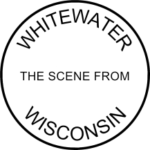 This is the eighth post in a series considering related local topics of cultures & communications within the city.
This is the eighth post in a series considering related local topics of cultures & communications within the city.
Just beyond the Whitewater proper lie several towns that form the rest of the Whitewater Unified School District. They play a key role in life within Whitewater, far beyond school policies.
A few observations:
The New Divide. Where once the main local issue was a town-gown divide within Whitewater (a divide that also represented political divisions between red and blue), the main divide now implicates small towns nearby. Whitewater proper (the city) will never be red again. The small towns nearby are likely to stay red, at least for years to come. See, Whitewater, Cultures & Communications, June 2017 (Part 6: Divided).
Affinity. In many ways, remaining red voters in the city have more in common with those in the nearby towns than they do with their fellow city residents. Whitewater’s red-leaning residents (especially the aged ones) are now probably closer politically with voters in the Lima Center or Richmond Township than they are with Whitewater’s average voter. I would venture that local politicians like Stewart or Binnie would run better outside the city than in it. It’s not that they couldn’t do well in the city – it’s that they’re now ideologically closer to those outside of it. They’ve not appreciably changed, but the whole city has evolved in ways that make their politics closer to those in nearby red towns.
Chief Otterbacher’s outlook certainly fits more closely with the towns near the city than within Whitewater.
Jan Bilgen’s longtime role on Whitewater’s PFC & as a university staffer who describes the students whose careers she’s supposed to be developing as though they were almost feral children, and Jim Winship’s political influence as a college professor who fought to restrict student housing from his own neighborhood, would probably play even better outside Whitewater than in it.
(Perhaps Winship would describe himself as a progressive, but his views on student housing have been a reactionary departure from, for example, genuine progressive Thurgood Marshall’s recognition of the importance of freedom of association against housing restrictions. I’ve written previously, from a libertarian viewpoint, in support of Marshall’s view, expressed in his dissent in Village of Belle Terre v. Borass, 416 U.S. 1 (1974). See, Whitewater’s Planning Commission Meeting from 5/10/10: Residential Overlay.)
The more conservative views outside the city have allowed, or encouraged, officials to advance red-leaning policies that would have been rejected within Whitewater proper. (District officials Runez, Parker, and Jaeger would all fall within this category – this, however, is a longer subject for another series. For now, a theory: professions of neutrality have actually advanced right-leaning policies with disregard to a majority of city residents’ views. Those internally who would normally be opposed to these policies often yield to the first belligerent reactionary they encounter. Others are co-opted with awards,, etc., and become advocates or appeasers of views they would reject if not for their easily-manipulated vanity.)
Unrequited. If those outside the city represent a more right-wing view that would fail within the city, what do they give in return for appeasement of their politics?
Not their money, to be sure: the longstanding move of retail shopping away from Whitewater shows that if those in towns nearby want to see an imposition of red views, they still take their money to places beyond Whitewater. Grocery shoppers in area towns, who once shopped in Whitewater, have shifted to other places for their needs; one of the main challenges of a co-op is simply gathering retail demand that has found satisfaction in other cities.
Previously: Parts 1 (introductory assumptions), 2 (population), 3 (oasis), 4 (demographics), 5 (working age), 6 (divided), and 7 (how it was supposed to be).
Tomorrow: Part 9.
